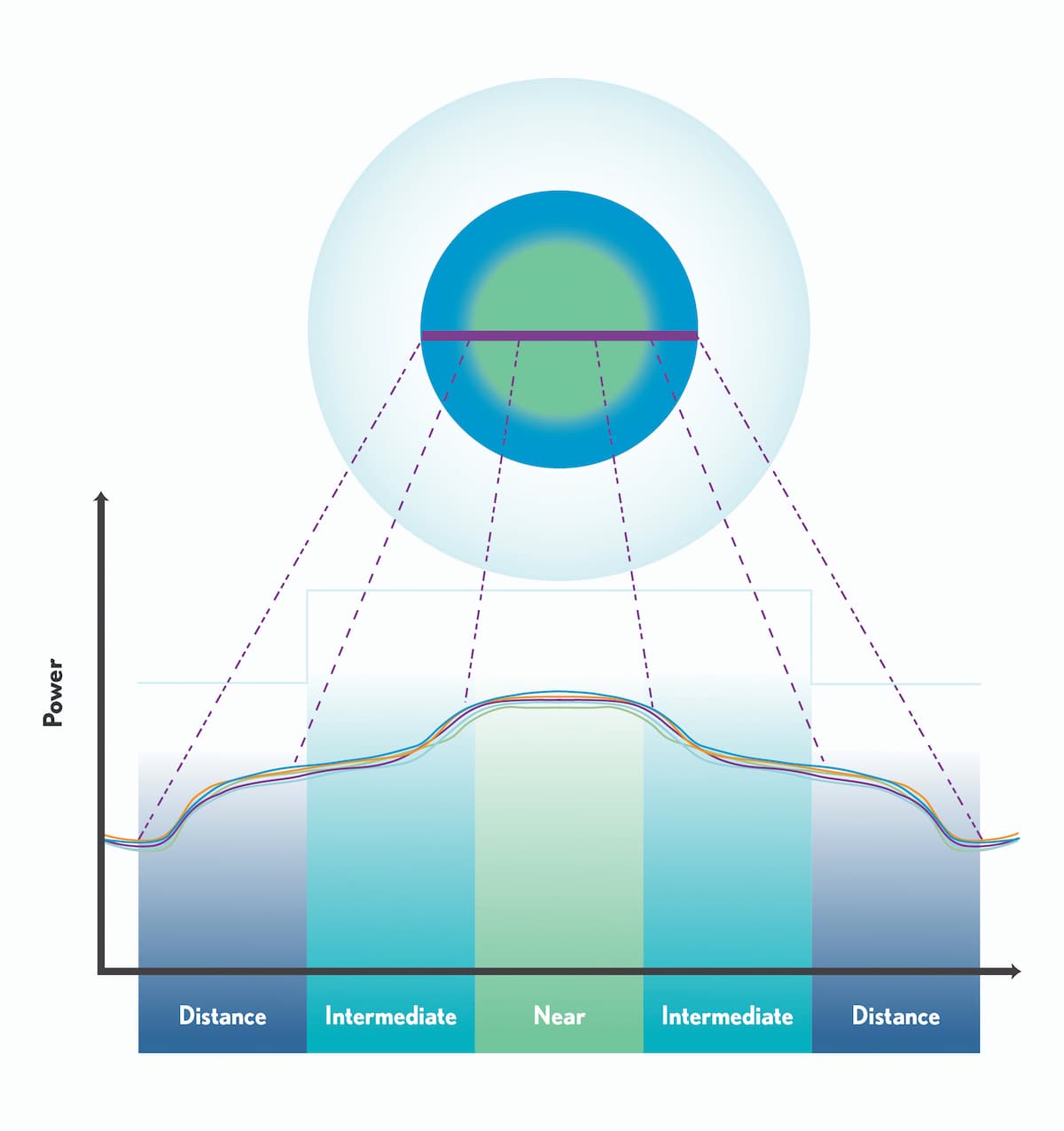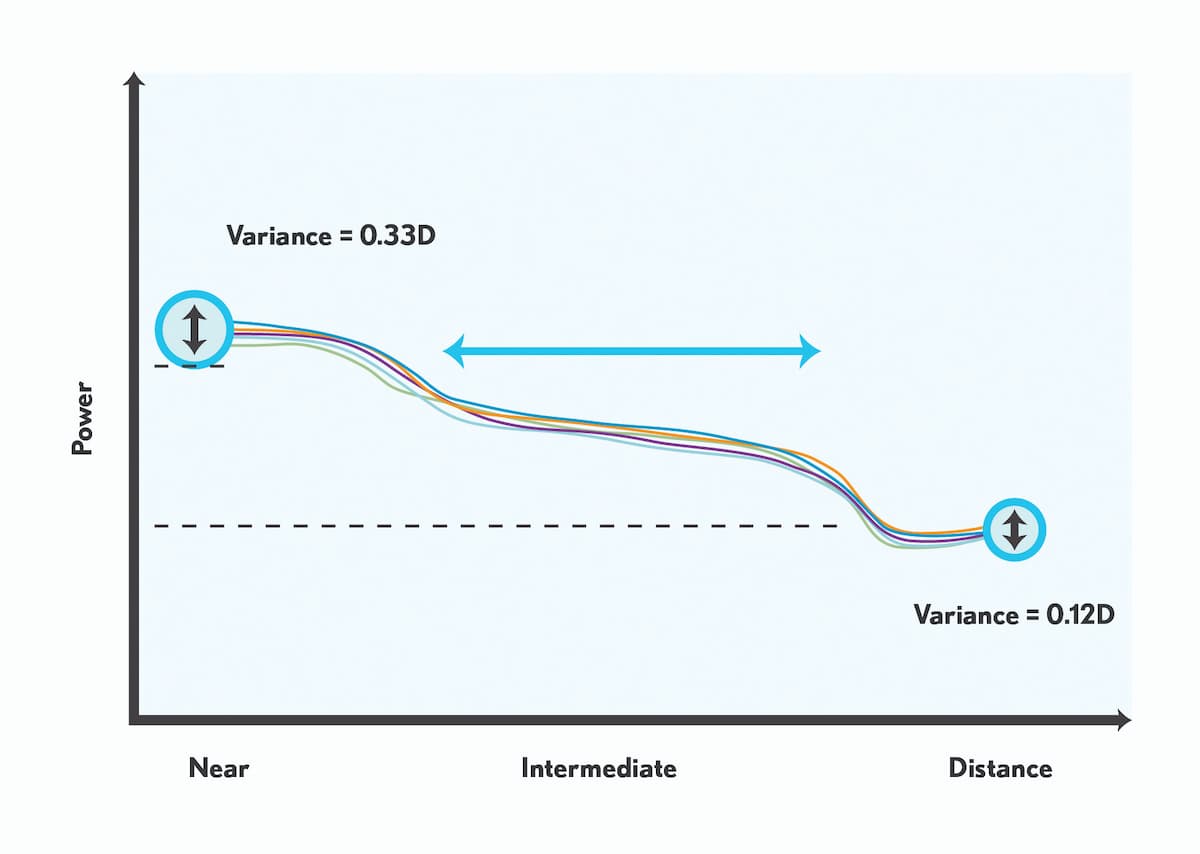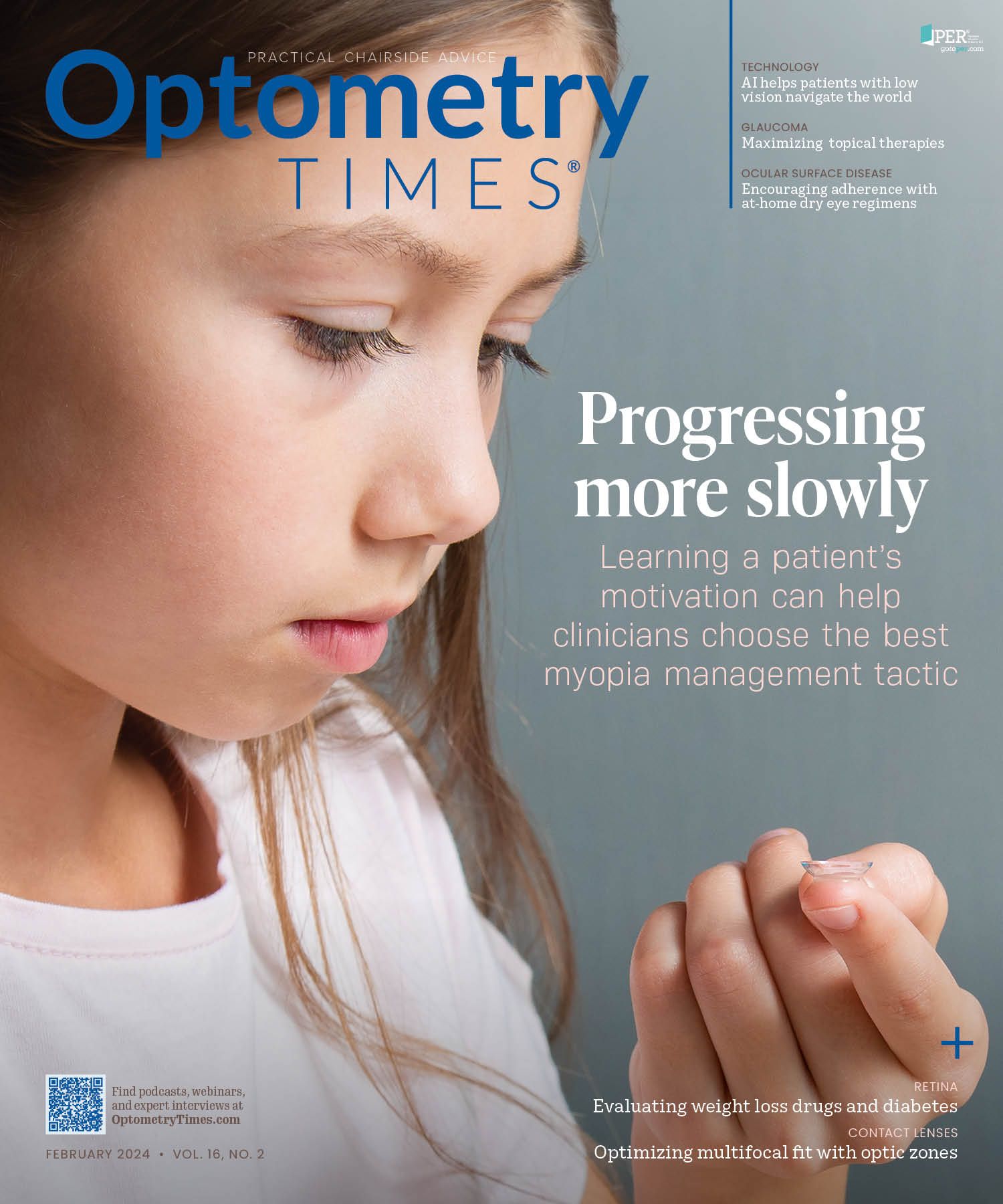Multifocal contact lens optics optimize the patient experience
An overview of the factors of lens development and their application in the real world for patients with presbyopia.
Image Credit: AdobeStock/AndreyPopov

A contact lens wearer’s perception of success depends on a host of factors. For presbyopes in particular, visual performance across all distances is essential for satisfaction. Indeed, poor vision (at distance, intermediate, or near) is cited as a leading reason for contact lens discontinuation among presbyopic wearers, reinforcing the importance of optical design in lens selection.1-3
Figure 1. Representative power profile of a center-near multifocal contact lens. Because lenses generally have radial symmetry, one side of a power profile is sufficient to illustrate the change in power from the center to the periphery.

Most current soft multifocal contact lenses are simultaneous-image designs that correct various distances over the pupil, with center-near, center-distance, and concentric-zone ring designs being the most common.4 To visualize multifocal contact lens designs and understand how they might perform on the eye, power profiles can be created using wavefront-sensing technology—specifically, a sophisticated, high-resolution Hartmann-Shack-based instrument capable of mapping more than 6000 unique power measurements over the central 6 mm of a contact lens. In brief, distortions of light passing through the lens are measured and converted into a profile that displays effective optical power, including the distribution and magnitude of add power in multifocal lenses (Figure 1).4
Power distribution and magnitude
Power distribution across the optic zone can provide valuable insight into relative similarities and differences among multifocal contact lenses. A power profile may show gradual, abrupt, or staircased transitions between near and distance portions of the lens optic zone. Large, abrupt steps with sharp transition zones may be associated with “ghosting” symptoms due to the rapid change in power, whereas constant staircased changes in power may reduce depth of focus.4
Center-near lenses may be more popular than other optical designs due to overall visual performance.5 However, there is substantial variation in power profiles even in the center-near lens category, with relatively high variance at near and distance portions of the lens observable in some power profiles.4
Factors in lens development
Pupil size is an oft-cited factor that can affect a multifocal contact lens’ visual performance, prompting contact lens manufacturers to incorporate individual pupil size considerations into lens designs.6,7 In some cases, pupil size is addressed by fitting a center-near lens in one eye and a center-distance lens in the contralateral eye; other lenses, such as the Acuvue multifocal lens design (Johnson & Johnson Vision), feature smaller concentric rings of near and distance power zones, which aim to provide “pupil independent” performance.4
A noteworthy approach found in several multifocal lenses is Bausch + Lomb’s 3-Zone Progressive design, which was arrived at via computer-generated eye models based on data from 180 eyes. Lens designers factored in multiple dynamic components, including pupil size as well as refraction, higher-order aberrations, anterior chamber depth, axial length, corneal curvature, corneal topography and diameter, depth of focus, accommodative amplitude, and residual accommodation across nine distances, to account for individual contact lens wearer variability.8
The eye modeling was used to predict logMAR visual acuity scores for thousands of computer-generated multifocal lens designs for each individual eye. The resulting 3-Zone Progressive design was found to improve near and intermediate vision, while continuing to provide excellent distance vision.
Figure 2. Power profiles of a 3-Zone Progressive lens normalized to a -3.0 D power, demonstrating areas of near, intermediate, and distance power, as well as consistency across the power range.

In lenses that use this design approach, the changes in power and diameters of each zone show wide areas of consistent power; within each zone, consistency in power corresponds with more concentration of light to deliver focused images (Figure 2).8 Beyond extensive computer eye modeling, Bausch + Lomb’s 3-Zone Progressive design also utilized finite element modeling software to predict the on-eye behavior of a contact lens.
Real-world performance
An ideal multifocal contact lens manages the amount of focused light on the retina by controlling the rate of change in power for each distinct zone responsible for near, intermediate, and distance vision. Smooth power transitions across the optical zone can translate to more seamless changes for wearers.4 The benefit can be realized in everyday situations, in which presbyopes must often alternate between dynamic vision tasks involving variable viewing distances (navigating directions on a digital device while driving, for example, or responding to text messages while working at a computer).
The consistency of measured powers across the available prescription range helps ensure a predictable fit from patient to patient.8 In addition, using manufacturer-provided fitting guides helps practitioners develop a smooth, reliable fitting process, minimizing chair time and maximizing the chances of success.9 More recently, online tools and apps are available to support lens fitting and selection, such as the OptiExpert app (CooperVision), the ClearFit app (Alcon), and the FitBetter app (Bausch + Lomb). The latter app provides lens recommendations from the extensive Bausch + Lomb product portfolio, multifocal and toric refinement recommendations, product information, and a visual acuity conversion tool in addition to fitting guides.
The bottom line
Selecting contact lenses for patients with presbyopia entails many considerations, including ocular surface health, patient motivation and expectations, patient lifestyle (including digital device usage), history with contact lens wear, material properties, age, amount of astigmatism, and refraction. For those who may be candidates for multifocal contact lenses, optical design, as illustrated by the contact lens power profile, can be a substantial contributor to visual performance, wearer satisfaction, and fitting success.
References:
Novillo-Díaz E, Villa-Collar C, Narváez-Peña M, Martín JLR. Fitting success for three multifocal designs: multicentre randomised trial. Cont Lens Anterior Eye. 2018;41(3):258-262. doi:10.1016/j.clae.2017.12.012
Rueff EM, Varghese RJ, Brack TM, Downard DE, Bailey MD. A survey of presbyopic contact lens wearers in a university setting. Optom Vis Sci. 2016;93(8):848-854. doi:10.1097/OPX.0000000000000881
Zeri F, Di Censi M, Livi S, Ercoli A, Naroo SA. Factors that influence the success of contact lens fitting in presbyopes: a multicentric survey. Eye Contact Lens. 2019;45(6):382-389. doi:10.1097/ICL.0000000000000606
Kim E, Bakaraju RC, Ehrmann K. Power profiles of commercial multifocal soft contact lenses. Optom Vis Sci. 2017;94(2):183-196. doi:10.1097/OPX.0000000000000998
Vedhakrishnan S, Vinas M, Benedi-Garcia C, Casado P, Marcos S. Visual performance with multifocal lenses in young adults and presbyopes. PLoS ONE. 2022;17(3):e0263659. doi:10.1371/journal.pone.0263659
Guillon M, Dumbleton K, Theodoratos P, Gobbe M, Wooley CB, Moody K. The effects of age, refractive status, and luminance on pupil size. Optom Vis Sci. 2016;93(9):1093-1100. doi:10.1097/OPX.0000000000000893
Moezzi AM, Varikooty J, Luensmann D, et al. The short-term physiological impact of switching reusable silicone hydrogel wearers into a hydrogel daily disposable multifocal. Clin Ophthalmol. 2019;13:1193-1202. doi:10.2147/OPTH.S208905
Reindel WT, Hovinga K, Musleh M. Impact of multifocal power profiles on visual outcomes. Contact Lens Spectrum. 2016 Oct
Schulze MM. Multifocal contact lens fitting: clinical pearls. Contact Lens Update. December 21, 2022. Accessed January 17, 2024. https://contactlensupdate.com/2022/12/21/multifocal-contact-lens-fitting-clinical-pearls/

Newsletter
Want more insights like this? Subscribe to Optometry Times and get clinical pearls and practice tips delivered straight to your inbox.